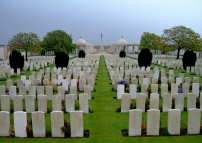| First Name: | Francis Edward | Last Name: | KNIGHT | |
|---|---|---|---|---|
| Date of Death: | 25/09/1915 | Lived/Born In: | Plaistow | |
| Rank: | Private | Unit: | Cameron Highlanders7 | |
| Memorial Site: | 1. Plaistow, West Ham Tramway Memorial 2. Loos Memorial, France | |||
Current Information:Born-Kingston The Battle of Loos, fought by the British Army from 25th September, 1915 through to 13th October, was conducted along a six-and-a-half-mile front running north from the mining village of Loos on the outskirts of Lens in Northern France. It was the largest offensive carried out by the British so far in the war. The opening day involved an attack by six divisions, with others entering the fray as it progressed and it was part of a much wider offensive with the French launching their own attacks in Champagne and at Vimy. It was the first time that the British used gas during the war, despite their condemnation of the Germans for doing the same in April 1915. There were some encouraging results on the first day but no major breakthrough was achieved and in the successive days the offensive became mired in trench warfare. By mid-October the battle had petered out with the British having suffered over 60,000 casualties during its course. 15th (Scottish) Division attacked on a frontage of 1500 yards astride the Béthune to Lens and Vermelles to Loos roads with their objectives being the Lens road and Loos road redoubts then to advance east down the valley and take the village of Loos. Their next objective was the German second position running between Hulluch and Lens. At zero, 6.30am, the leading battalions moved forward. On the left 46 Brigade advanced with 10th Scottish Rifles and 7th Scottish Borderers. They were hindered by the gas that lingered in the British lines. The old pattern smoke helmet was effective against gas but almost air proof too and many discarded it and suffered the consequences. There were only a few casualties in the first 40 yards but the gas and the smoke did not entirely hide the advance and two German machine guns then did a lot of damage until dealt with by bombers. Many men fell in no-man’s land but here the wire had been well cut and they were soon in the German front line where the few defenders were either captured or fled. At 7am, with the smoke screen rapidly dispersing the Loos Defences were reached. They were unmanned but the uncut wire caused delay giving two German machine guns in a house east of the cemetery and in Fort Glatz, the opportunity to inflict damage. On the right 44 Brigade attacked with 9th Black Watch and 8th Seaforth Highlanders. They entered Loos, followed by the supporting battalion, 7th Cameron Highlanders and took the Germans there by surprise. Many had to be winkled out of the cellars for the rest of the day and some were still there on the 28th April. Others resisted stubbornly until dealt with by bombers. Others fled. By 8am Loos was entirely in British hands and 46 Brigade had reached the line of trenches east of the Grenay-Hulluch road. From there some of them advanced across the open valley north of Loos and by 9.15am 7th Scottish Borderers and one company 12th Highland Light Infantry, 46 Brigade had reached the Lens road where attempts to make contact with 1st Division to the north proved unfruitful. At this stage the reserve Battalions moved up in the shape 10th Gordon Highlanders of 44 Brigade and 8th Scottish Borderers of 46 Brigade adding to the mass of men drawn together by the fighting in Loos. This mixed bunch continued the advance but in the confusion of battle they headed towards the top Hill 70 rather than to its eastern slopes. From the top of the hill they could see the Germans retreating so they followed, down the far-side of the hill. But the German second line was intact and well defended and fire from this brought this advance to a halt with the men of 15th Division desperately seeking cover wherever they could on the downward slope north of Cite St Laurent. 7th Royal Scots Fusiliers from 45 Brigade in reserve were sent up to reinforce the men on Hill and they dug in just behind the crest. Also from 45 Brigade, 6th Cameron Highlanders were sent up in support of the troops near Puits 14 and because of the failure of 1st Division’s attack on the left, they formed a defensive flank near Chalet Wood. Later in the day the other two battalions of 45 Brigade, 13th Royal Scots and 11th Argylle & Sutherland Highlanders moved up into Loos, During the night the Germans launched two counter attacks against 7th Royal Scots Fusiliers, below the summit of Hill 70 on the eastern side of Loos Crassier. Both attacks were repulsed. |
||||
| « Back to Search Results | ||||
| If you think any of the information shown here is incorrect, Click Here to submit your amends and comments | ||||




